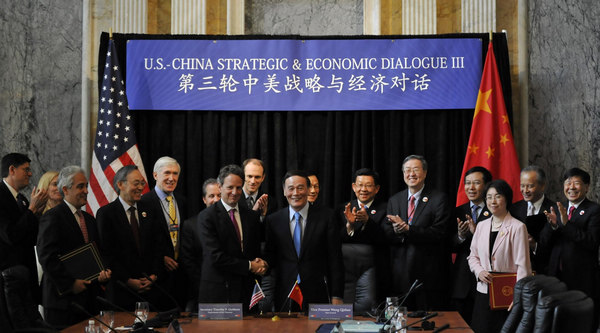News
China-US strategic dialogue yields tangible fruits
(Xinhua)
Updated: 2011-05-11 07:49
 |
Large Medium Small |
|
 US Treasury Secretary Tim Geithner and Chinese Vice-Premier Wang Qishan shake hands after participating in a signing ceremony for a "US-China Comprehensive Framework for Promoting Strong, Sustainable and Balanced Growth and Economic Cooperation", during the US-China Strategic and Economic Dialogue at the Treasury Department in Washington May 10, 2011. [Photo/Xinhua] |
WASHINGTON - China and the United States wrapped up the two-day China-US Strategic and Economic Dialogue (S&ED) here on Tuesday following comprehensive and productive discussions and yielded a host of constructive results.
The United States and China are building up more understanding and trust through the dialogue, while both sides are endeavoring to further deepen the bilateral ties in a range of different sectors, said US Secretary of State Hillary Clinton.
The strategic and economic dialogue continues to grow broader and deeper, and it reflects the complexity and importance of bilateral relationship, Clinton told reporters Tuesday, adding that "we have covered a lot of ground together and I am happy to report we have made a lot of progress".
Her view was echoed by Wang, saying that this round of S&ED built on the momentum of deepening bilateral ties and both sides endeavored to step up cooperation in the spirit of the consensus reached during Chinese President Hu Jintao's successful visit to the United States in January.
Clinton stressed that the world's largest two economies were working together to expand the areas where both cooperate and narrow the areas where both diverge.
Wang stated that the two sides had inked a framework of comprehensive economic cooperation at the current round of S&ED.
"The United States and China affirm that both countries will, based on common interest, promote more extensive economic cooperation, from a strategic, long-term, and overarching perspective, to work together to build a comprehensive and mutually beneficial economic partnership, add to prosperity and welfare in the two countries, and achieve strong, sustainable, and balanced growth of the world economy," noted the framework.
The world's largest two economies were committed to promoting strong, sustainable and balanced growth, as well as strengthening macroeconomic-policy communication and coordination.
"As the two largest economies in the world, economic outcomes and policy actions in the United States and China have a significant impact on the health of the global economy. The United States and China recognize and take into account the impact their policies have on the global economy, and cooperate to strengthen the international trade and financial institutions that support global growth and stability," according to the agreement.
Both countries aimed at taking measures to promote more balanced bilateral trade, resolving trade and investment disputes in a constructive and cooperative manner, exploring new cooperation opportunities in the process of transforming and restructuring their economies, developing sub-national economic cooperation and deepening cooperation in the financial sector.
The dialogue mechanism was upgraded from former Strategic Dialogue and biennial Strategic Economic Dialogue, which were initiated by the two heads of state in 2005 and 2006, respectively.
| 分享按钮 |


